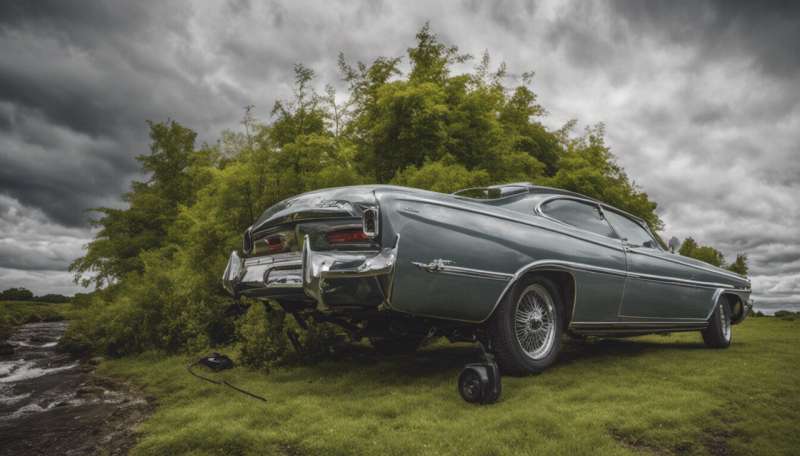This article has been reviewed according to Science X's editorial process and policies. Editors have highlighted the following attributes while ensuring the content's credibility:
fact-checked
trusted source
written by researcher(s)
proofread
Lough Neagh: UK and Northern Ireland's largest lake is being suffocated by business and agricultural interests

Lough Neagh is the largest freshwater lake in the UK and Ireland. It is a protected area of special scientific interest and the source of 40% of Northern Ireland's drinking water.
But it's also the site of a severe environmental crisis and a public health emergency. Located about 20 miles west of Belfast, the lough has turned thick with toxic blue-green algae, resulting in the demise of both its own wildlife and people's pets.
This situation has brought about a sense of mourning among local people and activists who, in September 2023, held a "wake" to highlight their fears that the lough is dying. Lough Neagh's historic fishing industry, which is known for its use of sustainable and traditional methods, also faces the threat of collapse unless conditions improve.
Multiple factors have made Lough Neagh particularly vulnerable to these perilous algal blooms, including rising water temperatures linked to global warming. However, the root causes of this crisis are decades of sand dredging and pollution stemming from agricultural runoff, sewage treatment and septic tanks. These activities have flooded the lough with nutrients on which the blue-green algae are thriving.
This crisis is far from a freak accident. It is the consequence of political negligence and institutional mismanagement, driven by an economy that has long prioritized growth over all else.
The same dynamic is responsible for the fragile state of nature throughout the rest of Northern Ireland. A recent report found that 12% of Northern Ireland's wild species are now facing extinction.
Any economy that presupposes the exploitation of finite natural resources to fuel the endless exponential growth it needs to function and survive cannot be sustained indefinitely. The crisis at Lough Neagh illustrates the grave consequences of attempting to do so.
It has become a place for extracting resources and a dump site for the chemical byproducts of agricultural activities that seek to produce as much as possible at the lowest financial cost.
Going for growth
Much of the groundwork for Northern Ireland's current environmental crisis was laid in 2013 by the Department of Agriculture, Environment and Rural Affairs' (Daera) landmark "Going for Growth" policy.
The policy promotes more market-led innovation and sales growth in highly competitive international markets. As a result, it has spurred the greater use of phosphates, nitrogen and other inputs within Northern Ireland's agricultural system.
It has also provided farmers with an incentive to intensify their beef and dairy production. This has led to the increased production of slurry. When slurry leaks into the environment, it has the potential to pollute water catchments and waterways.
The Going for Growth strategy was developed in the context of a general push for economic growth as part of Northern Ireland's "double transition", from war to peace and towards neoliberalism. Declared as "open for business" by political leaders, Northern Ireland has since become an attractive destination for various forms of socially and environmentally detrimental extractive economic activities.
These activities include gold mining in the Sperrin Mountains. Dalradian, the company proposing the project, claims the mine could provide a £750 million boost to the Northern Ireland economy.
Institutional mismanagement
The environmental impact of the Going for Growth strategy has been compounded by a general lack of regulatory oversight, policing and punishment of the pollution that accompanies it.
Still today, Northern Ireland does not have an independent environmental protection agency. The regulatory body it does have, the Northern Ireland Environment Agency, is part of Daera, the very government department tasked with promoting growth within and through the agriculture and food manufacturing industry.
The unfettered way in which growth is promoted and pursued shows how short-term economic interests have been prioritized to the detriment of the future viability of sustainable food production and ecological stability in Northern Ireland. There is an absence of suitable policies and initiatives to support rapid change towards a sustainable food system and a just transition for farmers.
Powerful vested interests
These failures of governance are further complicated at Lough Neagh by a messy network of stakeholders with vested interests in its economic, rather than social and ecological value. This includes a colonial legacy of ownership, through which the Earl of Shaftesbury enjoys the rights of an "absentee landlord" over the lough's bed and soil, even though its water is publicly owned.
The earl profits from these "business assets" through royalties from sand dredging. However, he argues that the current state of the water in Lough Neagh is not his responsibility and won't relinquish his private ownership without significant compensation from public funds. In the past, the amount of compensation he would require has been estimated to stand at £6 million.
This network of stakeholders also includes a politically powerful agricultural sector. The sector has been successful in lobbying for reduced government oversight and increased state financial support.
Meanwhile, local people are disenfranchised in their ability to influence how the lough, the largest ecological commons on the island of Ireland, is managed and to whose benefit.
Given the political, regulatory and powerful vested interests involved, alongside issues with mismanagement, perhaps the real question here is not how and who is responsible for killing Lough Neagh but rather why this decline did not happen sooner.
Our only hope now is that this situation serves as a catalyst for Northern Ireland to rectify its practices and start on a path towards environmental restoration.
Provided by The Conversation
This article is republished from The Conversation under a Creative Commons license. Read the original article.![]()
















